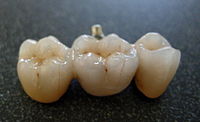
Photo from wikipedia
This research aimed to study a Bi–Ag–Mg soldering alloy and the direct soldering of Al2O3 ceramics and Ni–SiC composites. Bi11Ag1Mg solder has a broad melting interval, which mainly depends on… Click to show full abstract
This research aimed to study a Bi–Ag–Mg soldering alloy and the direct soldering of Al2O3 ceramics and Ni–SiC composites. Bi11Ag1Mg solder has a broad melting interval, which mainly depends on the silver and magnesium content. The solder starts to melt at a temperature of 264 °C. Full fusion terminates at a temperature of 380 °C. The microstructure of the solder is formed by a bismuth matrix. The matrix contains segregated silver crystals and an Ag (Mg, Bi) phase. The average tensile strength of solder is 26.7 MPa. The boundary of the Al2O3/Bi11Ag1Mg joint is formed by the reaction of magnesium, which segregates in the vicinity of a boundary with a ceramic substrate. The thickness of the high-Mg reaction layer at the interface with the ceramic material was approximately 2 μm. The bond at the boundary of the Bi11Ag1Mg/Ni–SiC joint was formed due to the high silver content. At the boundary, there were also high contents of Bi and Ni, which suggests that there is a NiBi3 phase. The average shear strength of the combined Al2O3/Ni–SiC joint with Bi11Ag1Mg solder is 27 MPa.
Journal Title: Materials
Year Published: 2023
Link to full text (if available)
Share on Social Media: Sign Up to like & get
recommendations!